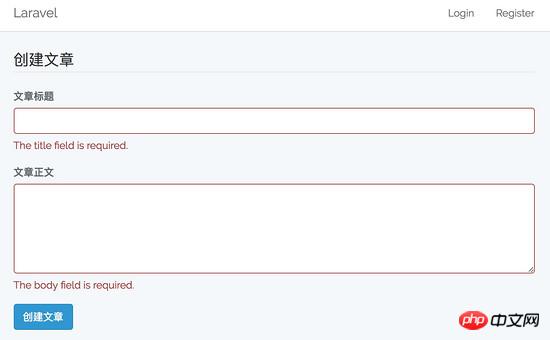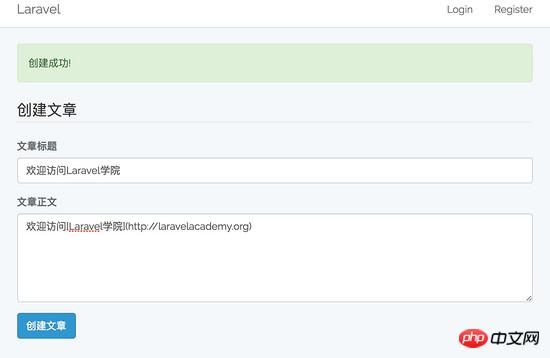Implementing Ajax form validation examples using Vue.js in Laravel
This article mainly introduces the use of Vue.js in Laravel to implement the Ajax-based form submission error verification function. It is very good and has reference value. Friends in need can refer to this tutorial
Based on Laravel 5.4
Before starting, first prepare the development environment. We assume that you have installed Laravel. As for the introduction of Vue, please refer to the official documentation.
After completing the above preparation work, we can start our development. In this tutorial, we will demonstrate the form verification of the article publishing page.
First add two routing rules in routes/web.php:
Route::get('post/create', 'PostController@create'); Route::post('post/save', 'PostController@save');
Then run Artisan command in the project root directory to create Controller PostController:
php artisan make:controller PostController
Add two new methods in the generated controller to handle routing requests:
public function create() {
return view('post.create');
}
public function save(Request $request) {
// 设置验证规则
$this->validate($request, [
'title' => 'required',
'body' => 'required'
]);
}The next step is to create a response view, in order to reuse the existing styles and Page layout , we first run the following Artisan command:
php artisan make:auth
So that we can reuse the authentication function page layout that comes with Laravel, create the view file post/create.blade.php, and edit the file The content is as follows:
@extends('layouts.app')
@section('content')
<p class="container">
<!--创建成功显示消息-->
<p class="alert alert-success" v-if="submitted">
创建成功!
</p>
<!--页面提交之后阻止刷新-->
<form @submit.prevent="createPost" method="POST">
<legend>创建文章</legend>
<!--如果title字段验证失败则添加.has-error-->
<p class="form-group" :class="{'has-error':errors.title}">
<label>文章标题</label>
<input type="text" name="title" class="form-control" v-model="post.title" value="{{ old('title') }}">
<!--如果验证失败通过FormError组件显示错误信息-->
<form-error v-if="errors.title" :errors="errors">
@{{errors.title.join(',')}}
</form-error>
</p>
<!--如果body字段验证失败则添加.has-error-->
<p class="form-group" :class="{'has-error':errors.body}">
<label>文章正文</label>
<textarea name="body" class="form-control" rows="5" v-model="post.body">{{ old('body') }}</textarea>
<!--如果验证失败通过FormError组件显示错误信息-->
<form-error v-if="errors.body" :errors="errors">
@{{errors.body.join(',')}}
</form-error>
</p>
<button type="submit" class="btn btn-primary">创建文章</button>
</form>
</p>
@endsectionThe page visited at this time is empty because we have not defined Vue-related data variables. The layouts.app layout view references app.js, and this js is provided by resources/assets/js /app.js is compiled, so we are going to define Vue-related code here:
var app = new Vue({
el: '#app',
data: {
post: {
title: '',
body: ''
},
errors: [],
submitted: false
},
methods: {
createPost: function () {
var self = this;
axios.post('/post/save', self.post).then(function(response) {
// form submission successful, reset post data and set submitted to true
self.post = {
title: '',
body: '',
};
// clear previous form errors
self.errors = '';
self.submitted = true;
}).catch(function (error) {
// form submission failed, pass form errors to errors array
self.errors = error.response.data;
});
}
}
});We also saw form-error in the view file, which is actually a sub-component in Vue. We can Create this new component file in the resources/assets/js/components directory. A sample Example.vue is provided in this directory. We can refer to this example to write a new FormError.vue:
<template>
<span class="help-block">
<slot></slot>
</span>
</template>
<script>
export default {
props: ['errors']
}
</script>Here We pass the data errors in the parent component to the child component to display error information in the child component. After completing the creation of the subcomponent, don't forget to introduce it in the above resources/assets/js/app.js:
Vue.component('form-error', require('./components/FormError.vue'));
In this way, we have completed all the coding work, and then run the following command to recompile js:
npm run dev
Of course in the development environment, we prefer to use npm run watch . This command will monitor changes in the front-end resource files and then recompile them to avoid manual compilation after each modification.
In this way, when you access the post/create page in the browser, it will be displayed normally:

Fill in nothing, click the create button, and the page will be The error message can be displayed:

After filling in the corresponding fields and then submitting, it will prompt that the creation is successful:

This way , we have completed a simple Ajax form submission verification function based on Vue in Laravel. Personally, I feel that it has significantly improved development efficiency.
The above is the detailed content of Implementing Ajax form validation examples using Vue.js in Laravel. For more information, please follow other related articles on the PHP Chinese website!

Hot AI Tools

Undresser.AI Undress
AI-powered app for creating realistic nude photos

AI Clothes Remover
Online AI tool for removing clothes from photos.

Undress AI Tool
Undress images for free

Clothoff.io
AI clothes remover

Video Face Swap
Swap faces in any video effortlessly with our completely free AI face swap tool!

Hot Article

Hot Tools

Notepad++7.3.1
Easy-to-use and free code editor

SublimeText3 Chinese version
Chinese version, very easy to use

Zend Studio 13.0.1
Powerful PHP integrated development environment

Dreamweaver CS6
Visual web development tools

SublimeText3 Mac version
God-level code editing software (SublimeText3)

Hot Topics
 Laravel Introduction Example
Apr 18, 2025 pm 12:45 PM
Laravel Introduction Example
Apr 18, 2025 pm 12:45 PM
Laravel is a PHP framework for easy building of web applications. It provides a range of powerful features including: Installation: Install the Laravel CLI globally with Composer and create applications in the project directory. Routing: Define the relationship between the URL and the handler in routes/web.php. View: Create a view in resources/views to render the application's interface. Database Integration: Provides out-of-the-box integration with databases such as MySQL and uses migration to create and modify tables. Model and Controller: The model represents the database entity and the controller processes HTTP requests.
 Understanding Vue.js: Primarily a Frontend Framework
Apr 17, 2025 am 12:20 AM
Understanding Vue.js: Primarily a Frontend Framework
Apr 17, 2025 am 12:20 AM
Vue.js is a progressive JavaScript framework released by You Yuxi in 2014 to build a user interface. Its core advantages include: 1. Responsive data binding, automatic update view of data changes; 2. Component development, the UI can be split into independent and reusable components.
 Solve caching issues in Craft CMS: Using wiejeben/craft-laravel-mix plug-in
Apr 18, 2025 am 09:24 AM
Solve caching issues in Craft CMS: Using wiejeben/craft-laravel-mix plug-in
Apr 18, 2025 am 09:24 AM
When developing websites using CraftCMS, you often encounter resource file caching problems, especially when you frequently update CSS and JavaScript files, old versions of files may still be cached by the browser, causing users to not see the latest changes in time. This problem not only affects the user experience, but also increases the difficulty of development and debugging. Recently, I encountered similar troubles in my project, and after some exploration, I found the plugin wiejeben/craft-laravel-mix, which perfectly solved my caching problem.
 Laravel user login function
Apr 18, 2025 pm 12:48 PM
Laravel user login function
Apr 18, 2025 pm 12:48 PM
Laravel provides a comprehensive Auth framework for implementing user login functions, including: Defining user models (Eloquent model), creating login forms (Blade template engine), writing login controllers (inheriting Auth\LoginController), verifying login requests (Auth::attempt) Redirecting after login is successful (redirect) considering security factors: hash passwords, anti-CSRF protection, rate limiting and security headers. In addition, the Auth framework also provides functions such as resetting passwords, registering and verifying emails. For details, please refer to the Laravel documentation: https://laravel.com/doc
 What versions of laravel are there? How to choose the version of laravel for beginners
Apr 18, 2025 pm 01:03 PM
What versions of laravel are there? How to choose the version of laravel for beginners
Apr 18, 2025 pm 01:03 PM
In the Laravel framework version selection guide for beginners, this article dives into the version differences of Laravel, designed to assist beginners in making informed choices among many versions. We will focus on the key features of each release, compare their pros and cons, and provide useful advice to help beginners choose the most suitable version of Laravel based on their skill level and project requirements. For beginners, choosing a suitable version of Laravel is crucial because it can significantly impact their learning curve and overall development experience.
 Laravel framework installation method
Apr 18, 2025 pm 12:54 PM
Laravel framework installation method
Apr 18, 2025 pm 12:54 PM
Article summary: This article provides detailed step-by-step instructions to guide readers on how to easily install the Laravel framework. Laravel is a powerful PHP framework that speeds up the development process of web applications. This tutorial covers the installation process from system requirements to configuring databases and setting up routing. By following these steps, readers can quickly and efficiently lay a solid foundation for their Laravel project.
 How to view the version number of laravel? How to view the version number of laravel
Apr 18, 2025 pm 01:00 PM
How to view the version number of laravel? How to view the version number of laravel
Apr 18, 2025 pm 01:00 PM
The Laravel framework has built-in methods to easily view its version number to meet the different needs of developers. This article will explore these methods, including using the Composer command line tool, accessing .env files, or obtaining version information through PHP code. These methods are essential for maintaining and managing versioning of Laravel applications.
 How to learn Laravel How to learn Laravel for free
Apr 18, 2025 pm 12:51 PM
How to learn Laravel How to learn Laravel for free
Apr 18, 2025 pm 12:51 PM
Want to learn the Laravel framework, but suffer from no resources or economic pressure? This article provides you with free learning of Laravel, teaching you how to use resources such as online platforms, documents and community forums to lay a solid foundation for your PHP development journey from getting started to master.






